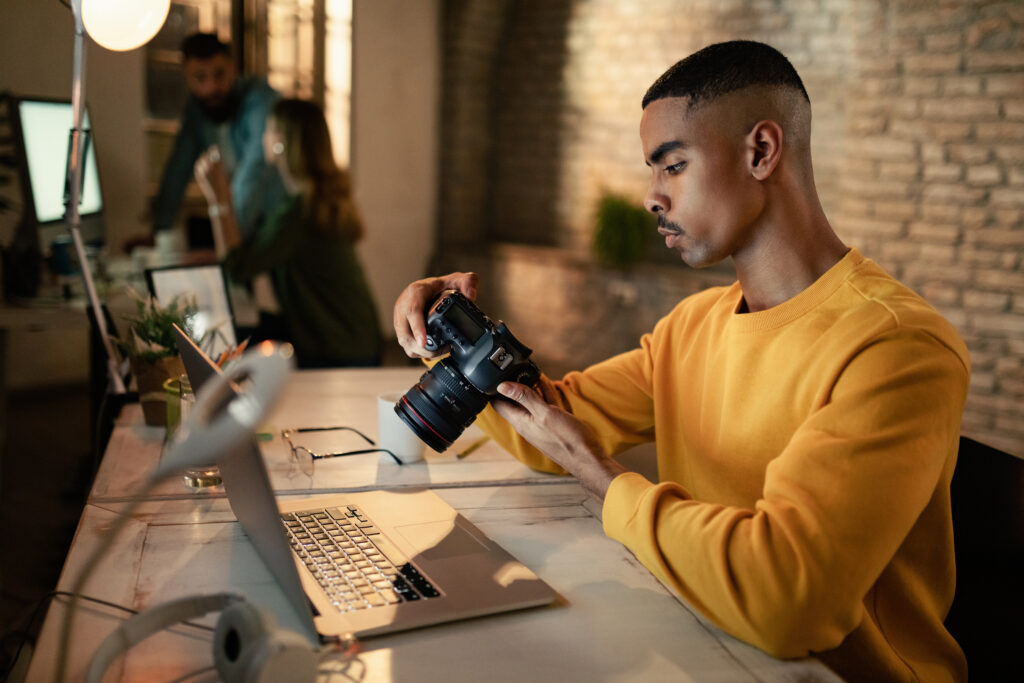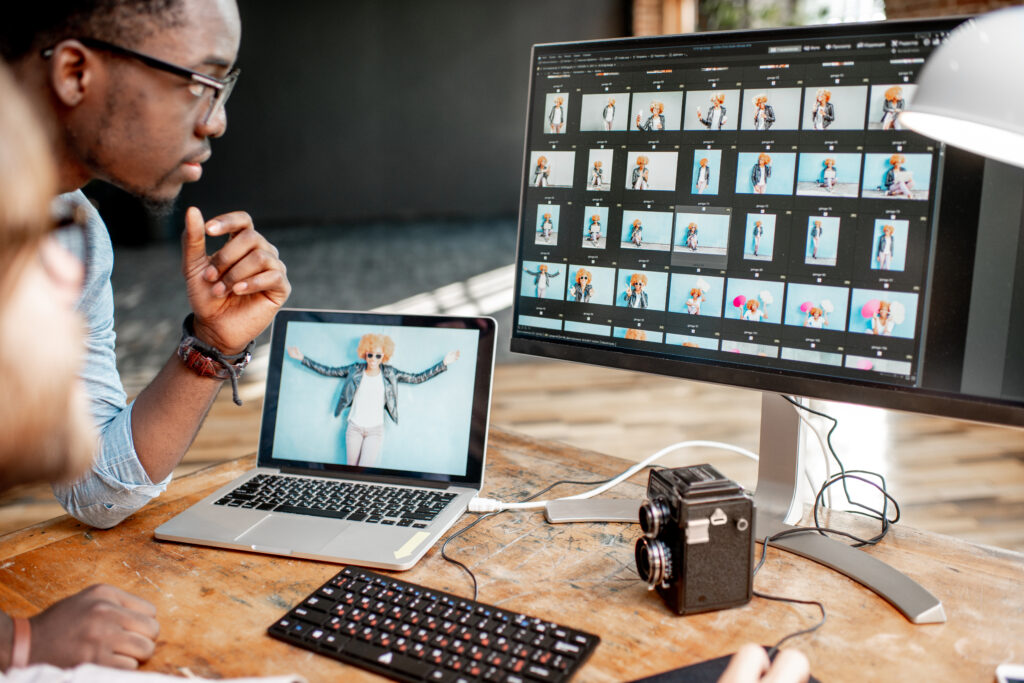Key Takeaways
- Name Your Images Correctly: Slap descriptive keywords on file names and alt text to make your shots pop up in searches.
- Make Your Site Snappy: Fast load times and mobile-friendly design keep visitors from bailing.
- Blog Like You’re Chatting: Share stories and tips to pull in traffic and show you know your stuff.
- Get Local Love: Connect with nearby businesses to rank for clients in your area.
- Track What Works: Use tools like Google Analytics to see what’s clicking and tweak your game plan.
A Portfolio That Nobody Saw
A photographer spends late nights editing—tweaking colors on a glowing desert sunset, perfecting the soft focus of a bride’s smile, or capturing the raw energy of a city street. They upload their work to a sleek website, hit publish, and wait. Weeks later, the stats show barely 50 visitors. A post on Photography.FYI’s forum told this story: one shooter’s portfolio was stunning but invisible. Search engines didn’t know their images existed, and clients never found them. It’s like hanging your best prints in a locked room.
SEO tips for photographers to rank higher aren’t complicated tech tricks. They’re practical steps to get your work in front of people who’ll book you. This guide pulls from real photographers’ experiences—folks who’ve struggled and figured out what works. It’s not about fancy jargon; it’s about making your portfolio pop up when someone searches “wedding photographer” or “landscape photos.” Let’s walk through how to do it, step by step, based on lessons from the field.
Getting Your Photography Website Noticed
1. Name Your Images So Search Engines Get It
Ever saved a photo as “IMG_7890.jpg”? It’s easy, but it tells Google nothing. Try naming files something clear, like “aspen-mountain-sunset.jpg,” and add alt text like “Aspen sunset landscape photography.” A photographer on Photography.FYI said they got 25% more traffic just by renaming 10 images. It’s a small change with big results.
You also need to compress images. Big files slow down your site, and slow sites lose visitors. Tools like TinyPNG cut file sizes without ruining quality. Google’s data says a 1-second delay can drop conversions by 7%—that’s clients clicking away. If you’re selling prints or licensing shots, use keywords like “fine art landscapes” or “stock portraits” to match what people search. Don’t overdo it; too many keywords feel forced and can hurt you. Photography.FYI has a guide on image optimization with more details. PetaPixel’s tips on quality versus speed are worth a look too. Need editing software? GearFocus had a used Lightroom license for $50 last week.

2. Make a Website People Actually Stick Around For
Ever hit a website that takes forever to load? You leave fast. So do your clients. Google tracks when people bounce—leave right away—and lowers your ranking if it happens a lot. Use Google PageSpeed Insights to spot problems, like oversized images or clunky themes. One photographer cut their bounce rate by 40% after switching to a simpler theme and a better host. It made a huge difference.
Over 60% of searches happen on phones, per Google’s 2024 numbers, so your site needs to work smoothly on mobile. Test it yourself: open your portfolio on your phone. Easy to navigate? Looks good? If not, fix it. Organize your work into clear sections—weddings, portraits, commercial—so people find what they want. One photographer got an annoyed email from a client who couldn’t find their wedding gallery buried in a messy menu. Photography.FYI’s article on website builders for photographers walks you through picking a good platform. For updating your site, GearFocus has used laptops, like a MacBook Pro for $700. B&H’s blog has solid mobile optimization advice too.
3. Blog to Share Your Know-How
Blogging might feel like extra work, but it’s a way to show what you know and pull in visitors. Write about stuff like “How to Get Great Golden-Hour Portraits” or “What I Learned Switching to Mirrorless Cameras.” A photographer on Photography.FYI posted about their Canon R6—bought used on GearFocus—and it hit Google’s first page, bringing in client emails. Posts like that show you’re legit and get traffic.
Aim for 800–1,200 words, slipping in SEO tips for photographers to rank higher without sounding robotic. Say you’re writing about low-light shots—mention a lens you love and link to a GearFocus listing. Keep old posts updated; Google likes fresh content. One photographer tweaked a 2019 post about their Nikon D850, and it started ranking again. Link to your portfolio pages in posts to keep people clicking around. Use terms like “photography advice” or “camera reviews” naturally. B&H’s blog has great examples of posts that rank well. Photography.FYI’s content guide is helpful too. GearFocus lists used cameras, like a Sony A7III for $900, for shooting blog photos.

4. Go Local to Find Nearby Clients
If you shoot weddings or portraits, local SEO is huge. Add keywords like “Austin wedding photographer” or “Portland portrait photography” to your site’s titles, descriptions, and a page just for local work. Get on Google My Business and ask clients for reviews—those help you show up higher. One photographer traded headshots for a local shop’s staff and got a link on their website, which boosted their ranking.
Reach out to nearby businesses—think venues, florists, or cafes. Offer to shoot their events or products for a mention or link back to your site. A photographer worked with a Denver bridal shop, got referrals, and ranked better for “Denver wedding photography.” Testimonials mentioning your city, like “Loved this Seattle photographer,” help too. Photography.FYI’s networking guide for photographers covers how to make these connections. DPReview has a good article on local marketing. For local gigs, GearFocus has used lighting kits, like a Profoto set for $400.
5. Check Your Progress and Keep Improving
SEO isn’t something you do once and forget. Tools like Google Analytics and Search Console show what’s bringing people to your site. One photographer saw “landscape photography tutorials” driving a ton of visits to a random post, so they wrote more like it and doubled their traffic in two months. Numbers tell you what’s working.
If pricey tools like Ahrefs are out of reach, try free ones like Ubersuggest for keyword ideas. Test new terms and see how they do. If “portrait photography tips” starts getting clicks, lean into it with more posts. Don’t just guess—use data. Photography.FYI’s performance tracking guide explains how to do this without getting lost in numbers. For running analytics, GearFocus has used desktops, like an iMac for $600. PetaPixel’s analytics article for photographers is a good read too.
6. Use Social Media to Bring in Traffic
Social media, like Instagram or Pinterest, can send people to your site, which helps Google see your content as valuable. Post behind-the-scenes shots or quick tips, and always link to your portfolio or blog. A photographer made a Pinterest board called “wedding photography ideas” that linked to their site and saw 20% more traffic. Use keywords like “outdoor wedding photos” in your posts to match what people search.
Answer comments, join X photography groups, and share your work. One photographer got better rankings by linking blog posts in Instagram Stories, which kept people on their site longer. Hashtags like #PhotographyTips or #WeddingPhotographer pull in curious folks. Photography.FYI’s social media guide for photographers has more on this. For social content, GearFocus has used smartphones, like an iPhone 13 Pro for $500, with great cameras.

7. Get Other Sites to Link to You
Links from other websites—backlinks—tell Google your site’s trustworthy. Don’t buy sketchy links; they can hurt your ranking. Instead, write guest posts for photography blogs or work with local businesses. One photographer did a guest post for a wedding site, linked to their portfolio, and got a 15% traffic bump. Try reaching out to PetaPixel or local magazines.
Make content others want to share, like a “Budget Photography Gear Guide.” Link to GearFocus for used gear deals, like a Canon 5D Mark IV for $1,000. A photographer posted a free lighting tips PDF on Photography.FYI’s forum, and other sites linked to it, helping their rank. Focus on quality links—10 good ones beat 100 bad ones. DPReview’s backlink guide for creatives has practical steps.
8. Spread Keywords Across Your Site
Keywords aren’t just for blogs or images—use them everywhere. Add SEO tips for photographers to rank higher to your homepage, about page, and service descriptions. A portrait photographer might put “natural light family portraits” in their bio or “Chicago headshots” on a services page. Keep it smooth, not stuffed.
Tools like AnswerThePublic show what clients search, like “affordable wedding photographer near me.” Use these in titles and descriptions. One photographer changed a page from “Engagement Photos” to “Top Engagement Photography Tips for Couples” and hit Google’s second page. Photography.FYI’s keyword guide has more on this. For site edits, GearFocus had a used Wacom tablet for $200, great for precision work.
9. Think About Voice Search
People use Siri or Google Assistant to find things like “wedding photographer near me.” Add question-style keywords to your content, like “Who’s the best portrait photographer in Miami?” or “How to pick a wedding photographer.” Put these in blog posts or an FAQ section.
One photographer made a Q&A page answering “What makes a great family photographer?” and got more local traffic from voice searches. Short, clear answers can land you in Google’s featured snippets, right at the top. Photography.FYI’s voice search guide for photographers explains how. For recording tutorials or podcasts, GearFocus has used mics, like a Rode for $80.
10. Write Content That Stays Relevant
Evergreen content—stuff like “How to Pose for Portraits” or “Gear for Beginner Photographers”—keeps pulling in visitors years later. One photographer wrote a “Travel Photography Camera Guide,” linked to their portfolio, and it still gets clicks. Update these posts to stay fresh for Google.
Use terms like “photography gear advice” and link to GearFocus deals, like a Nikon Z6 for $800. Evergreen posts build authority and get links from other sites. Photography.FYI’s timeless content guide has tips, and B&H’s blog shows examples that rank well.
11. Link Pages Within Your Site
Internal links—connecting your blog posts to portfolio pages or services—keep people on your site longer, which Google likes. A post about “Wedding Photography Tips” could link to your wedding gallery. One photographer added these links and saw 10% more time spent on their site.
Use clear link text, like “see my portrait portfolio,” not just “click here.” Photography.FYI’s internal linking guide shows how to do this right. For editing your site, GearFocus has used laptops, like a Dell XPS for $650.
12. Keep Up with SEO Changes
SEO shifts all the time. Blogs like Search Engine Journal or Moz cover Google’s updates, like recent ones focusing on page speed and mobile usability. One photographer improved their site’s mobile setup after a 2024 update and climbed search rankings.
Talk trends with other photographers on Photography.FYI’s forum. For gear to support SEO work, GearFocus has used monitors, like one for $150, good for multitasking.
13. Try New Ideas and Test Them
What works for one photographer might not for another. Test different blog lengths or niche keywords. One photographer tried “micro-wedding photography tips” and got more bookings. Tools like Google Optimize help compare page versions.
Check results with analytics to see what clicks. Photography.FYI’s experimentation guide has advice on testing content. For new visuals, GearFocus has used cameras, like a Sony A7III for $900.
14. Learn What Your Audience Wants
Google Analytics shows which pages and keywords bring people in. One photographer saw “street photography tips” driving traffic, so they wrote more and boosted their site. Analytics beat guesswork every time.
Free tools like Ubersuggest help if premium ones like SEMrush cost too much. Review data regularly to tweak your plan. Photography.FYI’s analytics guide makes it easy. GearFocus has used desktops, like an iMac for $600, for running analytics.
Conclusion: Get Your Work Seen
SEO tips for photographers to rank higher make your portfolio stand out to clients. From naming images right to connecting locally, these steps bring in traffic. Try one thing today—rename some photos or write a quick post—and see what happens. Share your results on Photography.FYI’s forum to swap ideas with others. Need gear? GearFocus has used cameras and lenses, like a Canon 5D Mark IV for $1,000. What’s your next move? Leave a comment and let’s talk.
FAQ: Common Questions About SEO for Photographers
What are the best SEO tips for photographers to rank higher?
Name images with keywords, make your site fast and mobile-friendly, write useful blog posts, target local searches, and use Google Analytics to track progress. Keep at it for results.
How do you optimize a photography portfolio for search engines?
Use descriptive file names and alt text, organize galleries clearly, and ensure quick load times. Link to portfolio pages from blogs to boost traffic.
Why does blogging help photographers rank higher?
Blogs bring in visitors, show your skills, and let you use keywords naturally. Link to sites like B&H for trust and share content that matters.
How does local SEO help photographers?
It puts you in front of clients searching “photographer in [city].” Use local keywords, list on Google My Business, and get links from nearby businesses.









